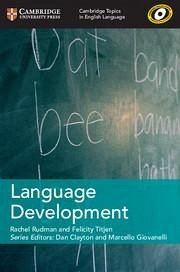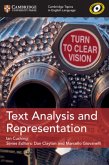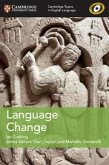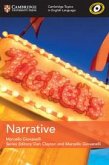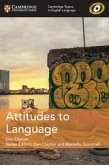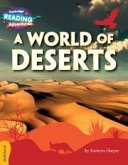Rachel Rudman, Felicity Titjen
Cambridge Topics in English Language Language Development
Herausgeber: Clayton, Dan; Giovanelli, Marcello
Rachel Rudman, Felicity Titjen
Cambridge Topics in English Language Language Development
Herausgeber: Clayton, Dan; Giovanelli, Marcello
- Broschiertes Buch
- Merkliste
- Auf die Merkliste
- Bewerten Bewerten
- Teilen
- Produkt teilen
- Produkterinnerung
- Produkterinnerung
Essential study guides for the future linguist.
Andere Kunden interessierten sich auch für
![Cambridge Topics in English Language Language and Gender Cambridge Topics in English Language Language and Gender]() Felicity TitjenCambridge Topics in English Language Language and Gender34,99 €
Felicity TitjenCambridge Topics in English Language Language and Gender34,99 €![Cambridge Topics in English Language Text Analysis and Representation Cambridge Topics in English Language Text Analysis and Representation]() Ian CushingCambridge Topics in English Language Text Analysis and Representation34,99 €
Ian CushingCambridge Topics in English Language Text Analysis and Representation34,99 €![Cambridge Topics in English Language Language Change Cambridge Topics in English Language Language Change]() Ian CushingCambridge Topics in English Language Language Change34,99 €
Ian CushingCambridge Topics in English Language Language Change34,99 €![Cambridge Topics in English Language Narrative Cambridge Topics in English Language Narrative]() Marcello GiovanelliCambridge Topics in English Language Narrative30,99 €
Marcello GiovanelliCambridge Topics in English Language Narrative30,99 €![Cambridge Topics in English Language Language and Power Cambridge Topics in English Language Language and Power]() Gary IvesCambridge Topics in English Language Language and Power34,99 €
Gary IvesCambridge Topics in English Language Language and Power34,99 €![Cambridge Topics in English Language Attitudes to Language Cambridge Topics in English Language Attitudes to Language]() Dan ClaytonCambridge Topics in English Language Attitudes to Language34,99 €
Dan ClaytonCambridge Topics in English Language Attitudes to Language34,99 €![Cambridge Reading Adventures a World of Deserts Gold Band Cambridge Reading Adventures a World of Deserts Gold Band]() Kathryn HarperCambridge Reading Adventures a World of Deserts Gold Band9,99 €
Kathryn HarperCambridge Reading Adventures a World of Deserts Gold Band9,99 €-
-
-
Essential study guides for the future linguist.
Hinweis: Dieser Artikel kann nur an eine deutsche Lieferadresse ausgeliefert werden.
Hinweis: Dieser Artikel kann nur an eine deutsche Lieferadresse ausgeliefert werden.
Produktdetails
- Produktdetails
- Cambridge Topics in English Language
- Verlag: Cambridge University Press
- Seitenzahl: 142
- Erscheinungstermin: 6. Februar 2018
- Englisch
- Abmessung: 228mm x 163mm x 7mm
- Gewicht: 192g
- ISBN-13: 9781108402279
- ISBN-10: 1108402275
- Artikelnr.: 48917538
- Herstellerkennzeichnung
- Libri GmbH
- Europaallee 1
- 36244 Bad Hersfeld
- gpsr@libri.de
- Cambridge Topics in English Language
- Verlag: Cambridge University Press
- Seitenzahl: 142
- Erscheinungstermin: 6. Februar 2018
- Englisch
- Abmessung: 228mm x 163mm x 7mm
- Gewicht: 192g
- ISBN-13: 9781108402279
- ISBN-10: 1108402275
- Artikelnr.: 48917538
- Herstellerkennzeichnung
- Libri GmbH
- Europaallee 1
- 36244 Bad Hersfeld
- gpsr@libri.de
1. Learning to talk: 1.1. Stages of acquisition in young children
1.2. Further development: grammar and phonology
1.3. Discourse development
2. Theories of spoken language acquisition: 2.1. An overview of theories behind spoken language acquisition
2.2. Timeline of language acquisition
2.3. The influence of environmental factors
2.4. Child-directed speech and its characteristics
3. Learning to read: 3.1. Books for young children
3.2. Overlaps between spoken language and literacy acquisition
3.3. Shared reading: its purposes and functions
3.4. Reading development stages
3.5. Understanding the conventions of written text
3.6. Different methods of teaching reading
3.7. Cues and miscues
3.8. The primary national strategy
4. Learning to write: 4.1. How do children learn to write?
4.2. How do children learn to spell?
4.3. How does grammar develop?
4.4. Genre-based model of writing pedagogy
4.5. Concerns over writing engagement and achievement
4.6. Educational approaches to teaching writing
5. Later Learning: 5.1. What is teen talk?
5.2. Social media platforms
5.3. Talk in the secondary education context
5.4. The changing nature of reading as it develops and adapts
5.5. Development of writing as young people mature
Ideas and answers
References.
1.2. Further development: grammar and phonology
1.3. Discourse development
2. Theories of spoken language acquisition: 2.1. An overview of theories behind spoken language acquisition
2.2. Timeline of language acquisition
2.3. The influence of environmental factors
2.4. Child-directed speech and its characteristics
3. Learning to read: 3.1. Books for young children
3.2. Overlaps between spoken language and literacy acquisition
3.3. Shared reading: its purposes and functions
3.4. Reading development stages
3.5. Understanding the conventions of written text
3.6. Different methods of teaching reading
3.7. Cues and miscues
3.8. The primary national strategy
4. Learning to write: 4.1. How do children learn to write?
4.2. How do children learn to spell?
4.3. How does grammar develop?
4.4. Genre-based model of writing pedagogy
4.5. Concerns over writing engagement and achievement
4.6. Educational approaches to teaching writing
5. Later Learning: 5.1. What is teen talk?
5.2. Social media platforms
5.3. Talk in the secondary education context
5.4. The changing nature of reading as it develops and adapts
5.5. Development of writing as young people mature
Ideas and answers
References.
1. Learning to talk: 1.1. Stages of acquisition in young children
1.2. Further development: grammar and phonology
1.3. Discourse development
2. Theories of spoken language acquisition: 2.1. An overview of theories behind spoken language acquisition
2.2. Timeline of language acquisition
2.3. The influence of environmental factors
2.4. Child-directed speech and its characteristics
3. Learning to read: 3.1. Books for young children
3.2. Overlaps between spoken language and literacy acquisition
3.3. Shared reading: its purposes and functions
3.4. Reading development stages
3.5. Understanding the conventions of written text
3.6. Different methods of teaching reading
3.7. Cues and miscues
3.8. The primary national strategy
4. Learning to write: 4.1. How do children learn to write?
4.2. How do children learn to spell?
4.3. How does grammar develop?
4.4. Genre-based model of writing pedagogy
4.5. Concerns over writing engagement and achievement
4.6. Educational approaches to teaching writing
5. Later Learning: 5.1. What is teen talk?
5.2. Social media platforms
5.3. Talk in the secondary education context
5.4. The changing nature of reading as it develops and adapts
5.5. Development of writing as young people mature
Ideas and answers
References.
1.2. Further development: grammar and phonology
1.3. Discourse development
2. Theories of spoken language acquisition: 2.1. An overview of theories behind spoken language acquisition
2.2. Timeline of language acquisition
2.3. The influence of environmental factors
2.4. Child-directed speech and its characteristics
3. Learning to read: 3.1. Books for young children
3.2. Overlaps between spoken language and literacy acquisition
3.3. Shared reading: its purposes and functions
3.4. Reading development stages
3.5. Understanding the conventions of written text
3.6. Different methods of teaching reading
3.7. Cues and miscues
3.8. The primary national strategy
4. Learning to write: 4.1. How do children learn to write?
4.2. How do children learn to spell?
4.3. How does grammar develop?
4.4. Genre-based model of writing pedagogy
4.5. Concerns over writing engagement and achievement
4.6. Educational approaches to teaching writing
5. Later Learning: 5.1. What is teen talk?
5.2. Social media platforms
5.3. Talk in the secondary education context
5.4. The changing nature of reading as it develops and adapts
5.5. Development of writing as young people mature
Ideas and answers
References.

